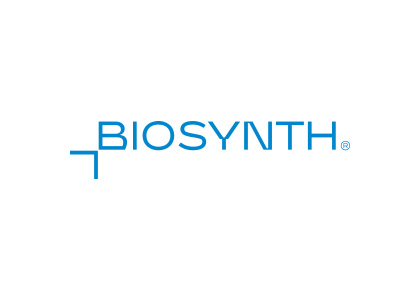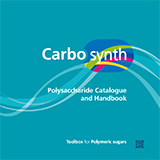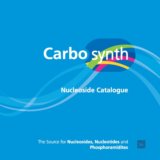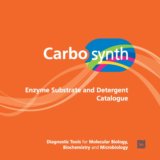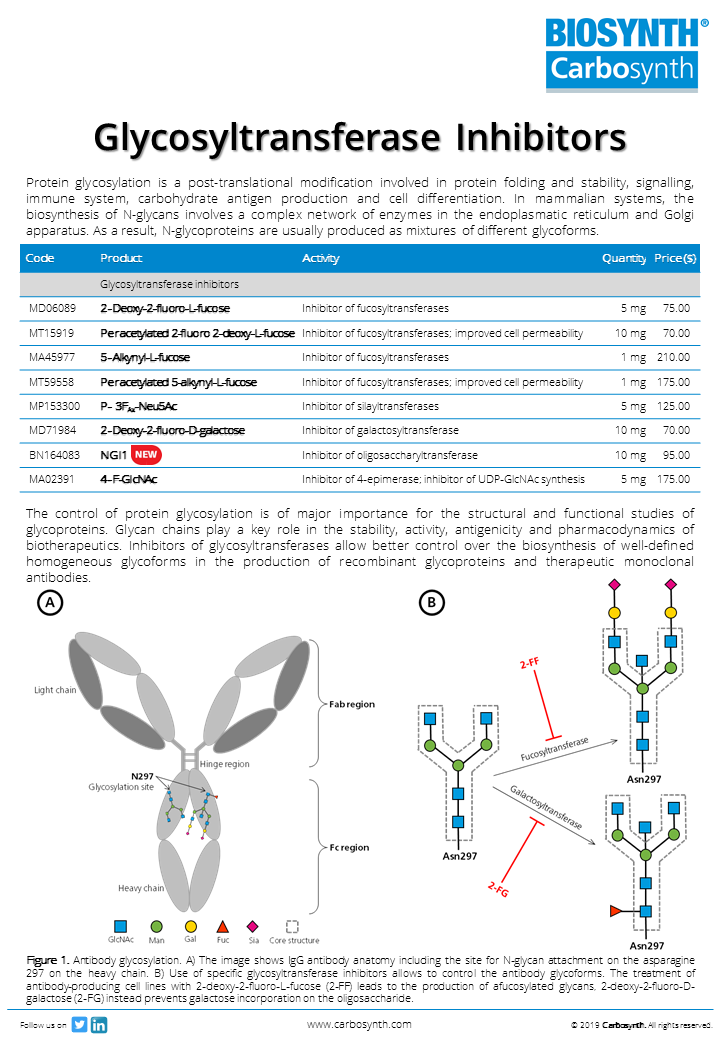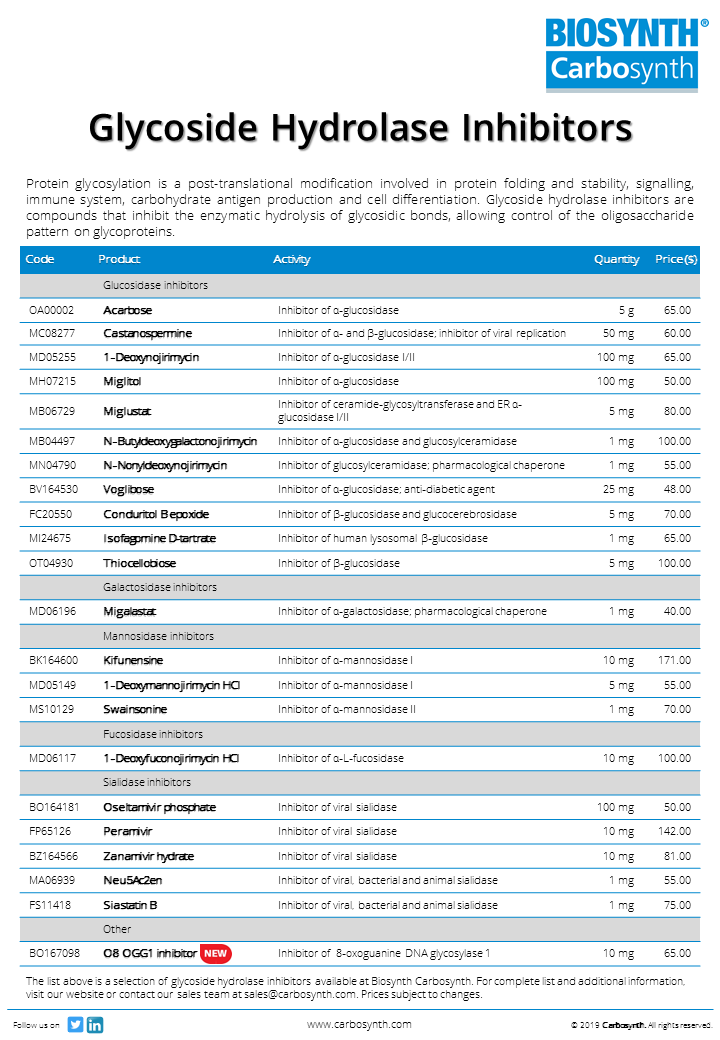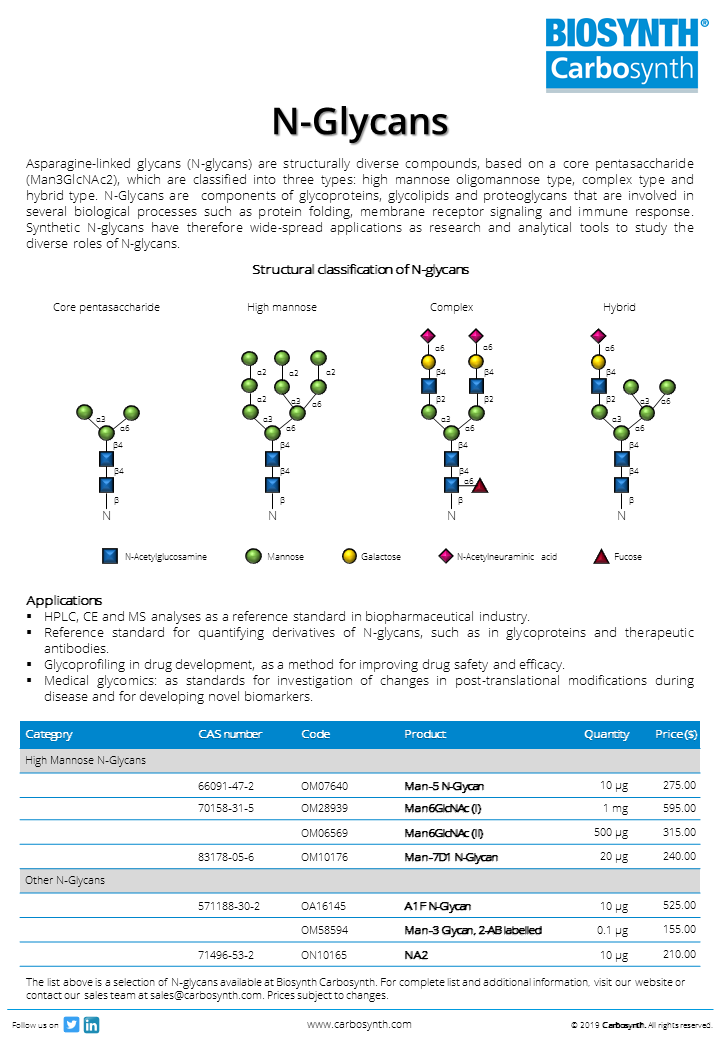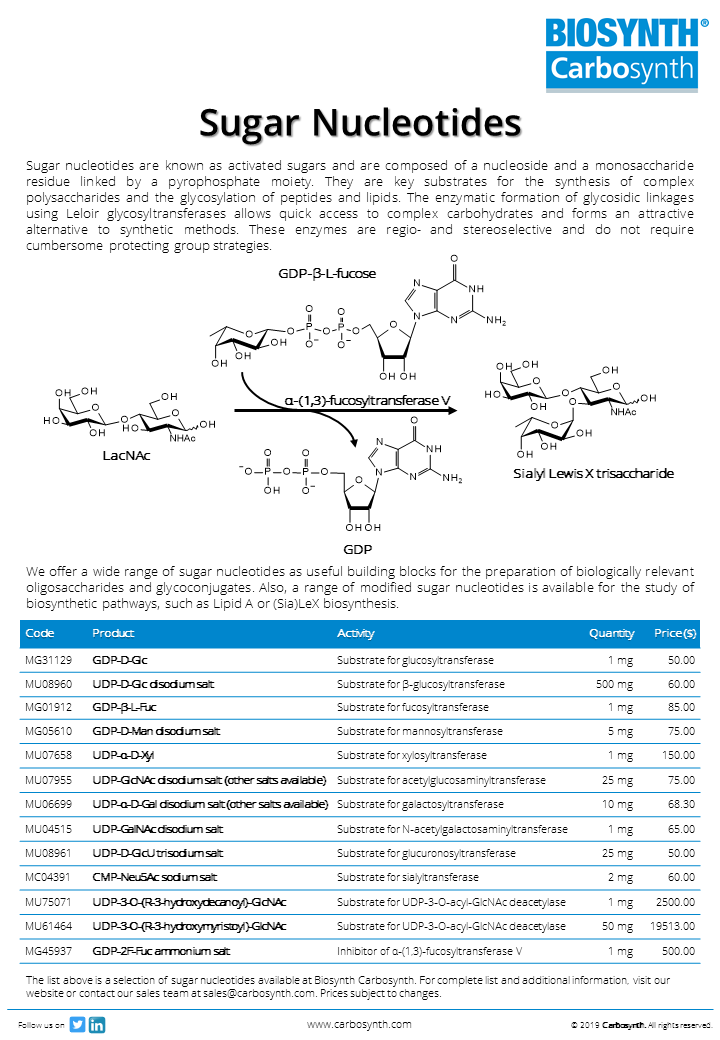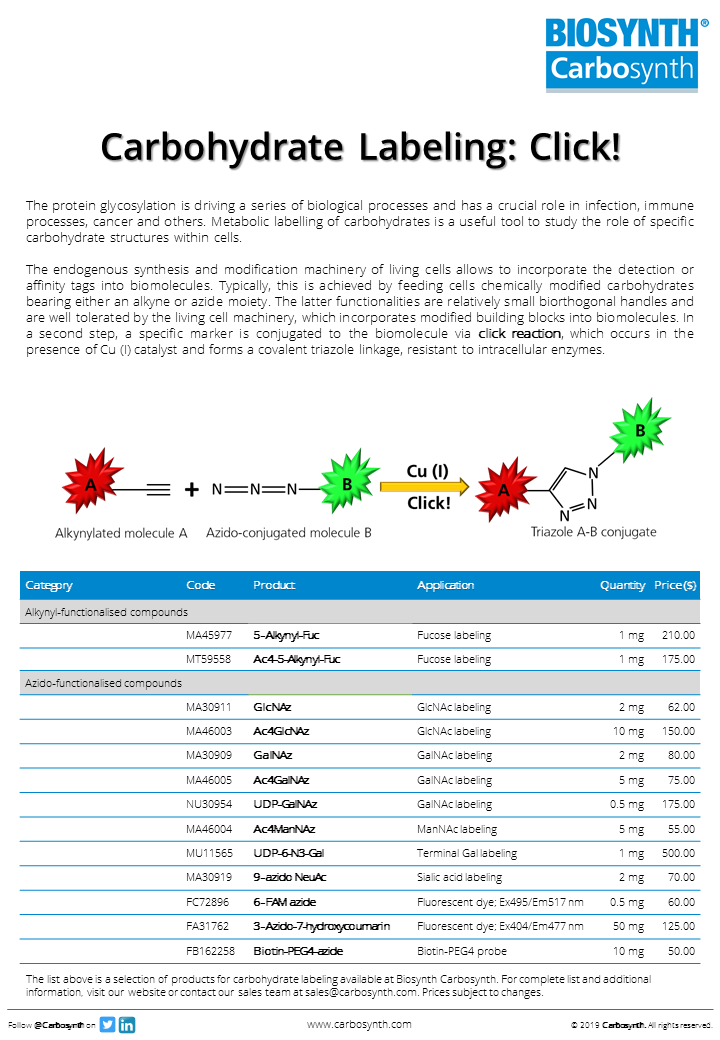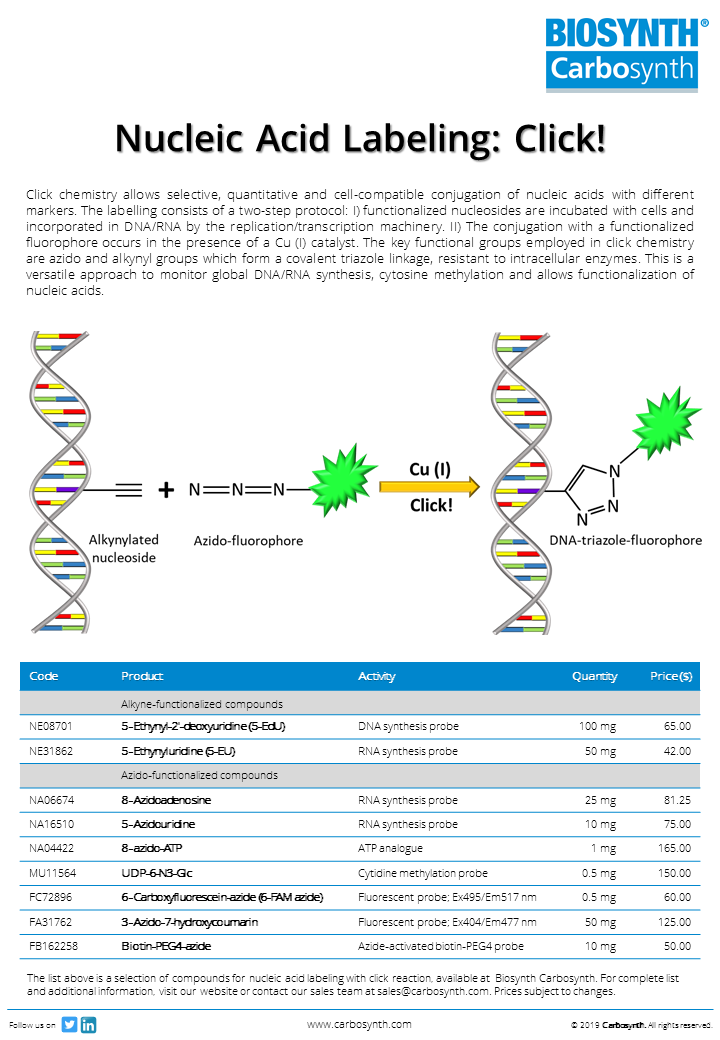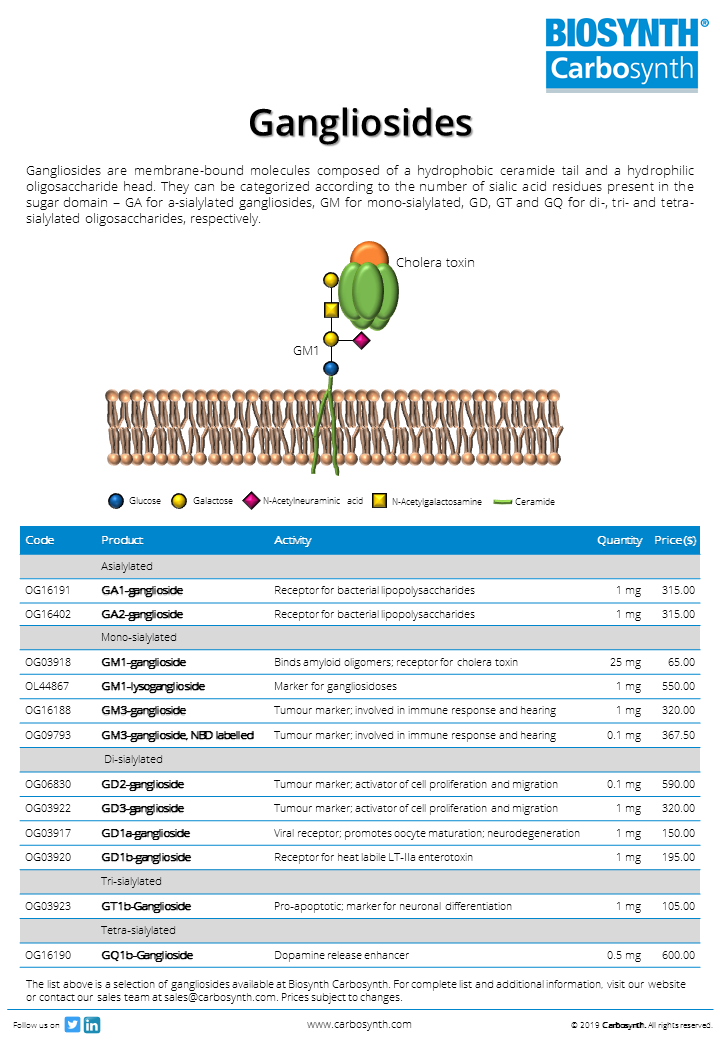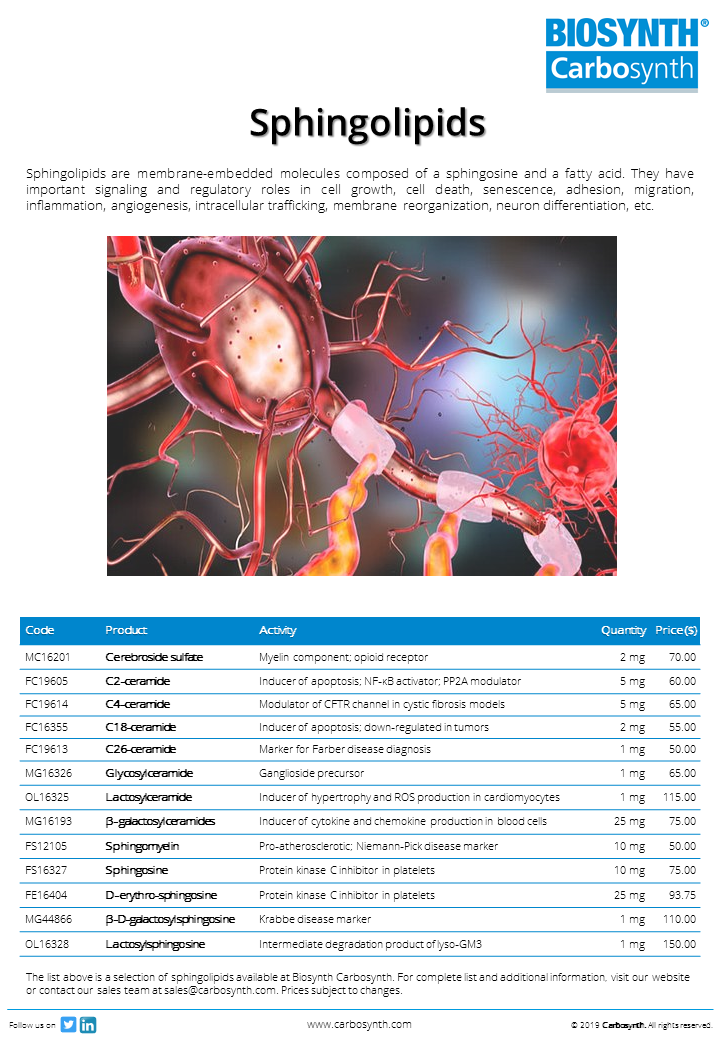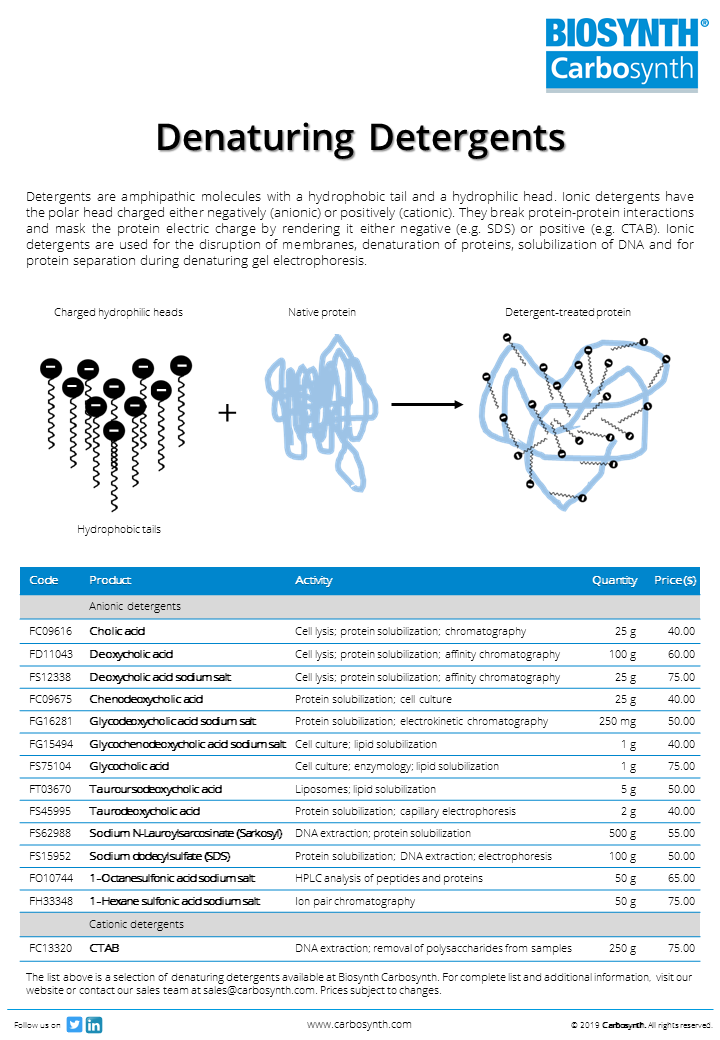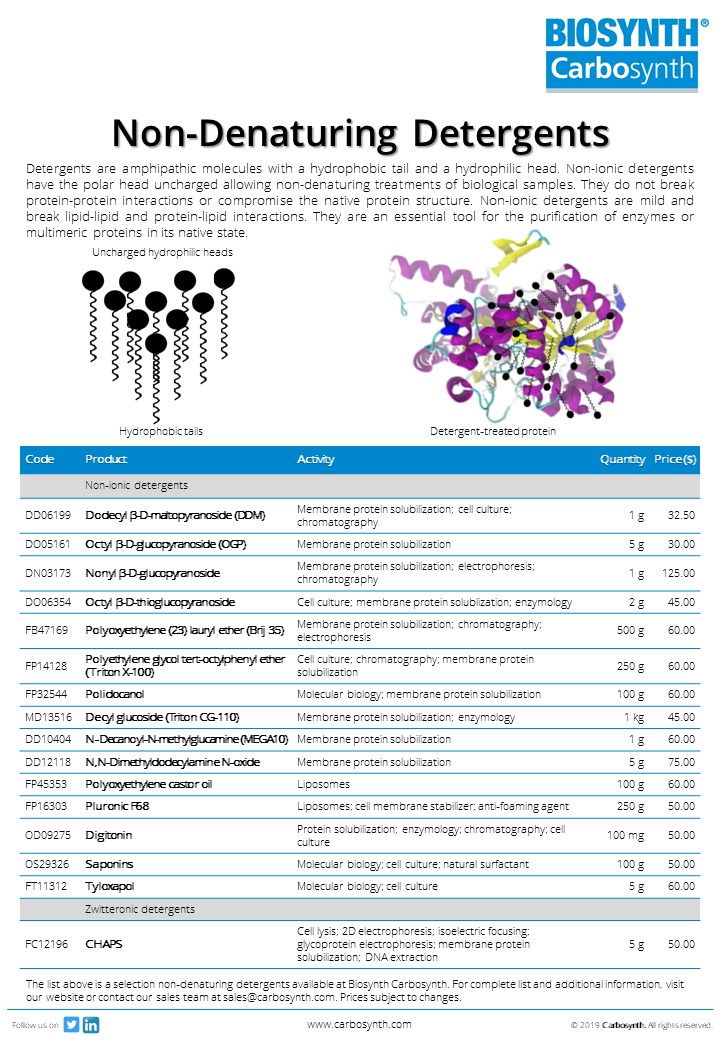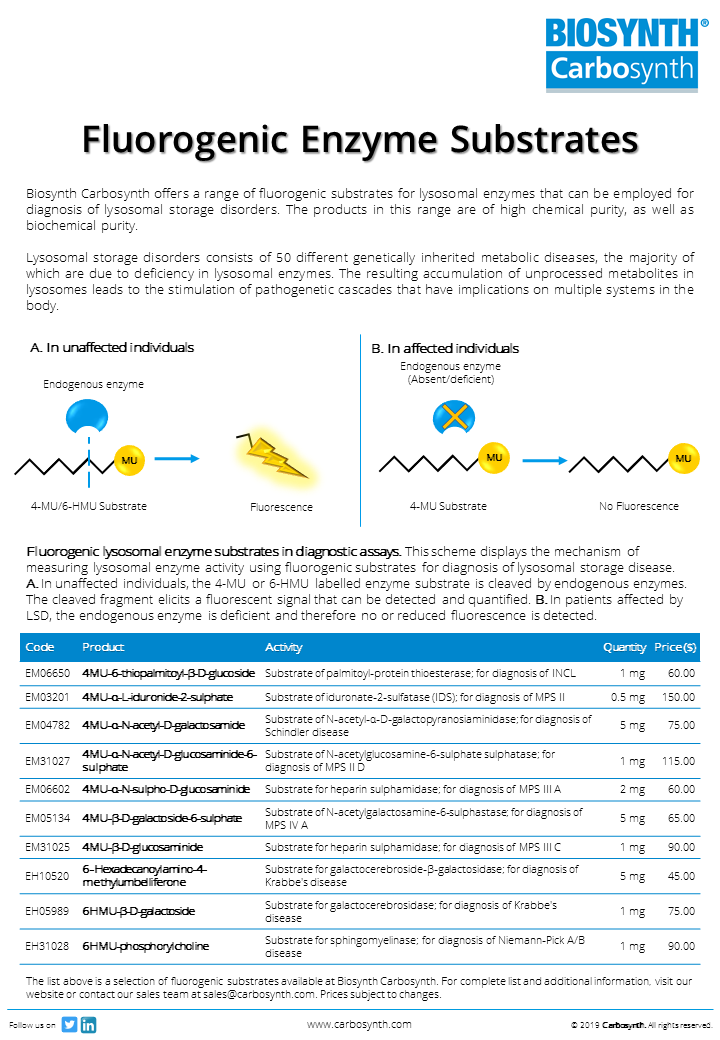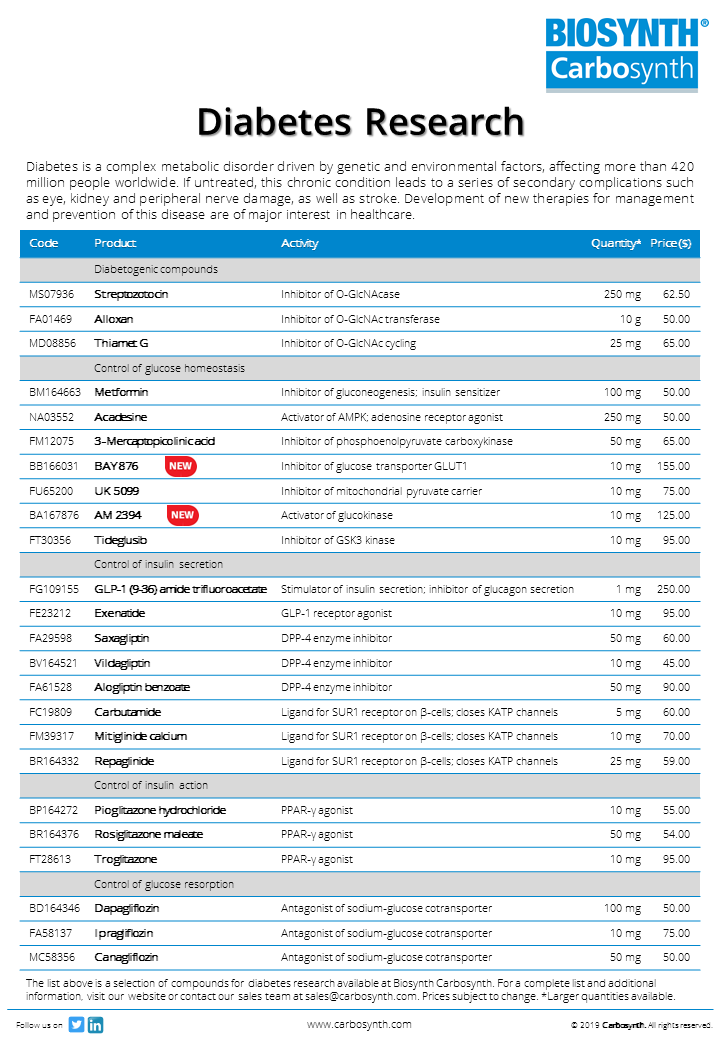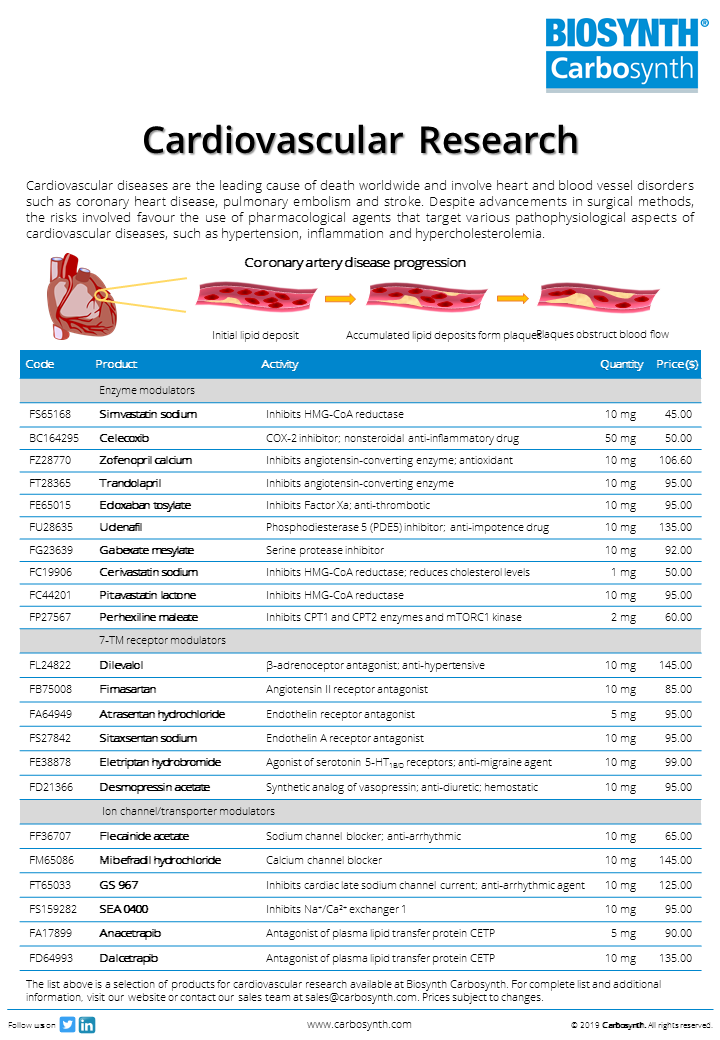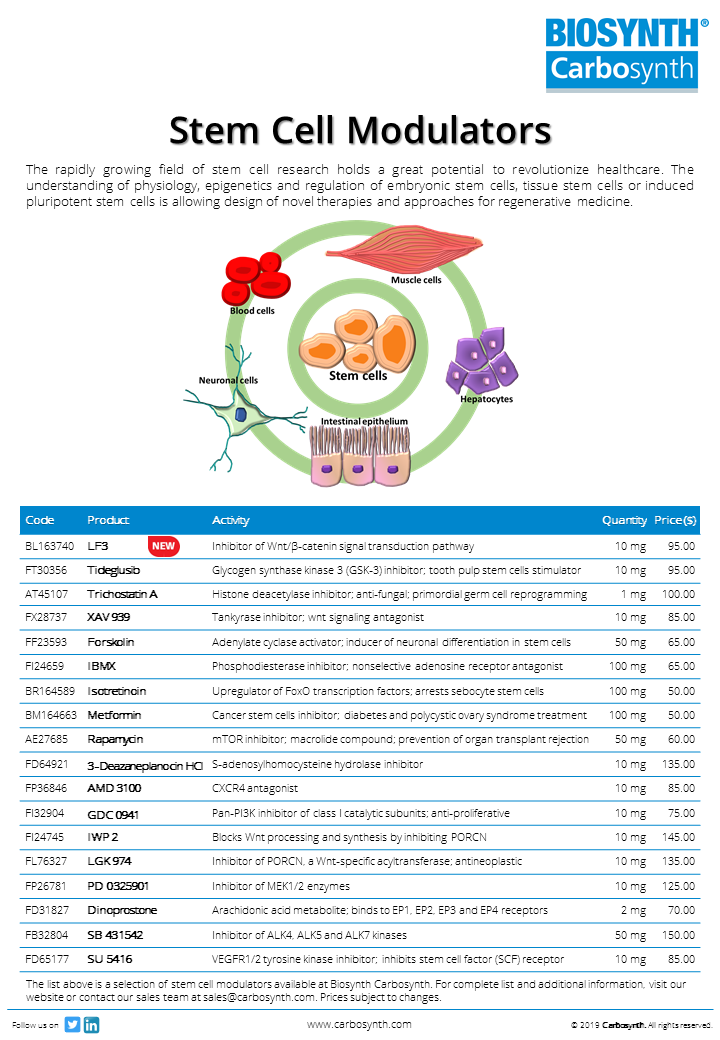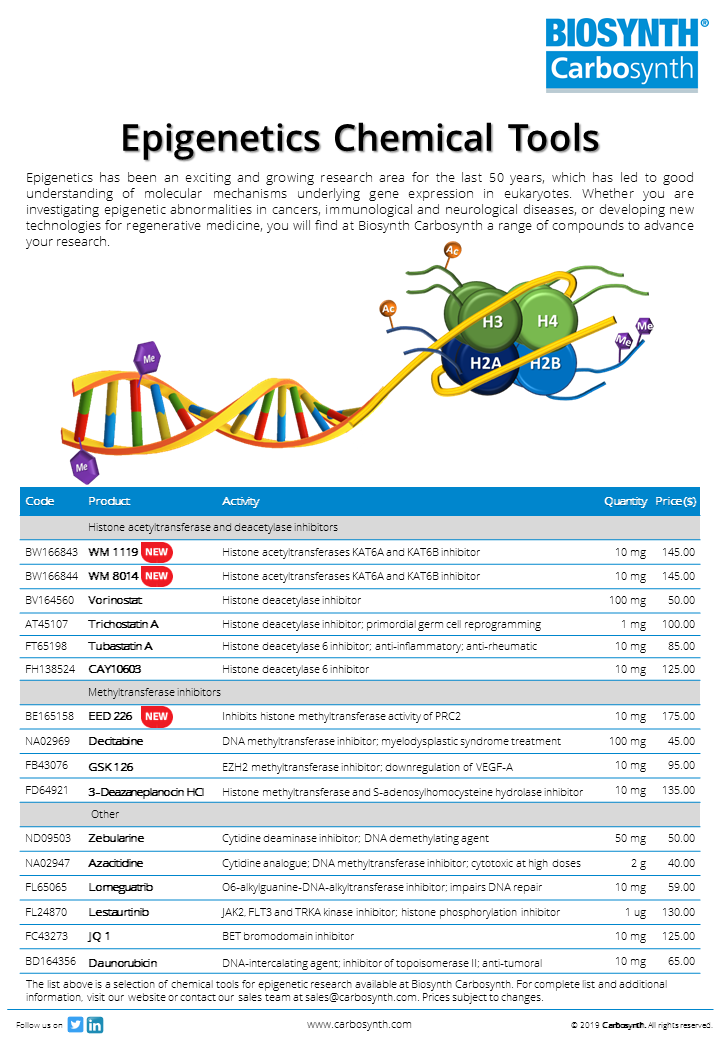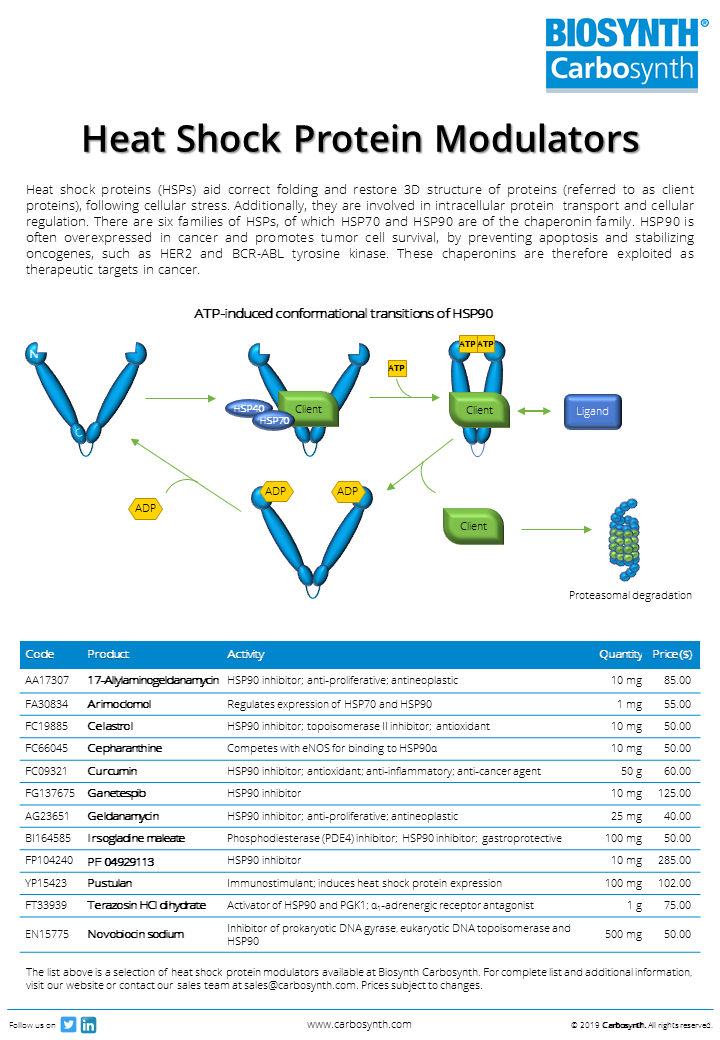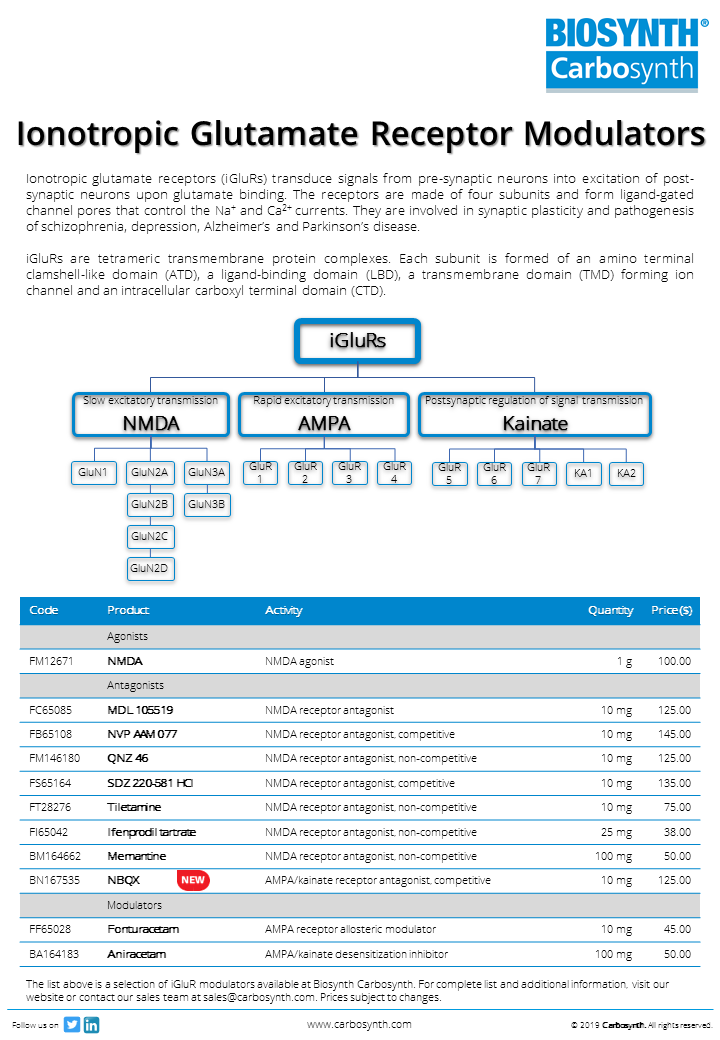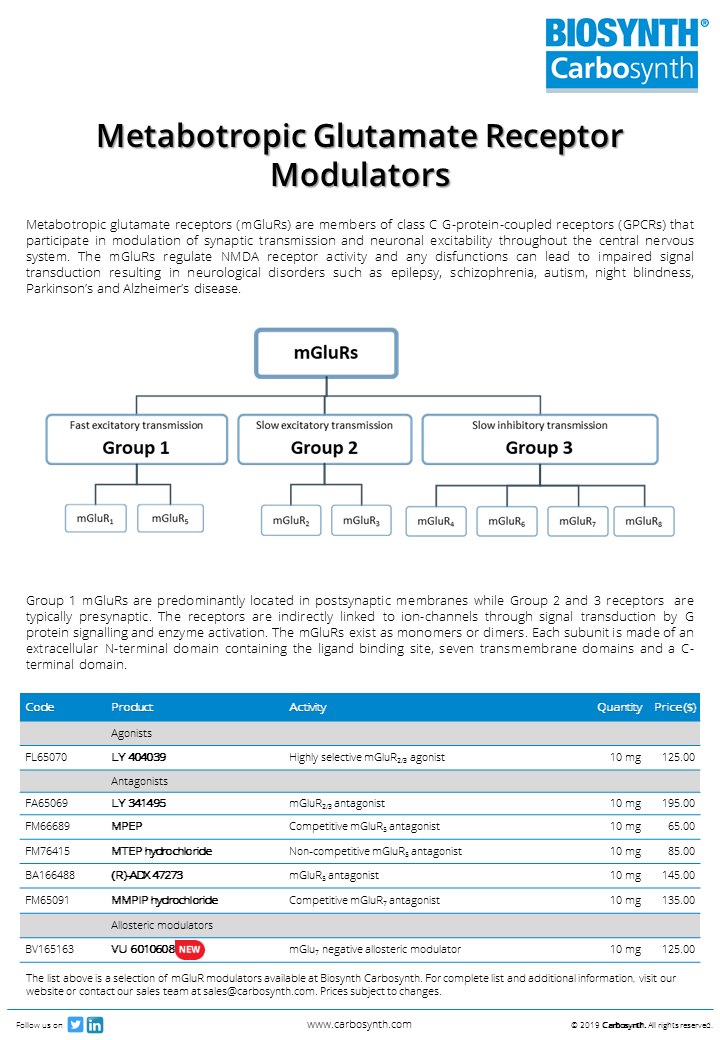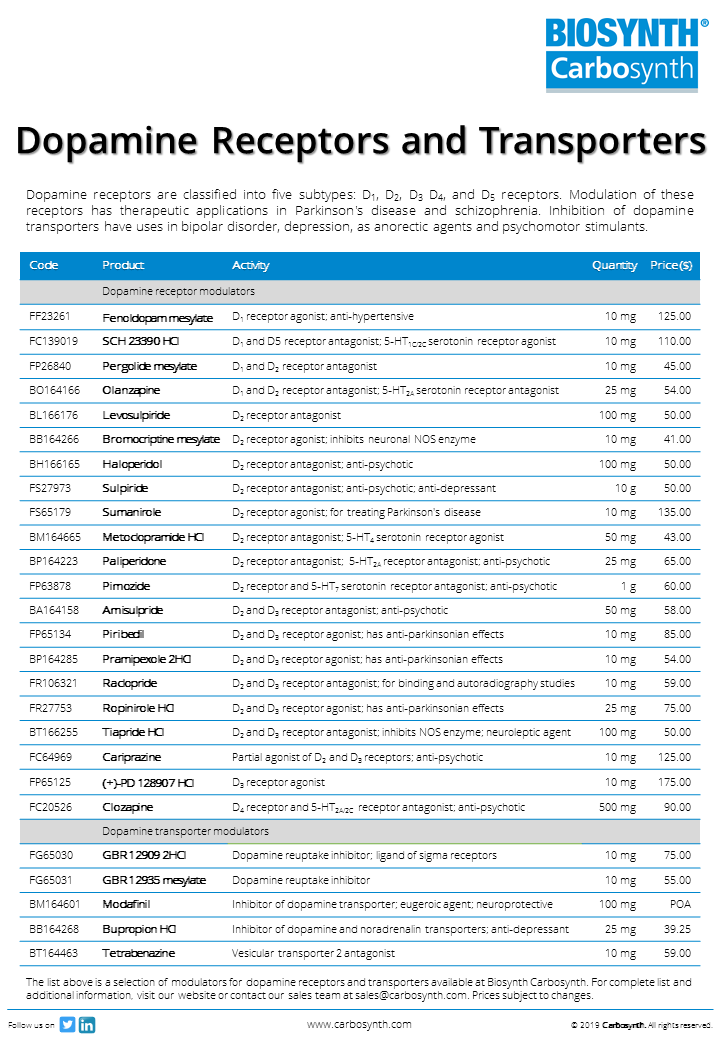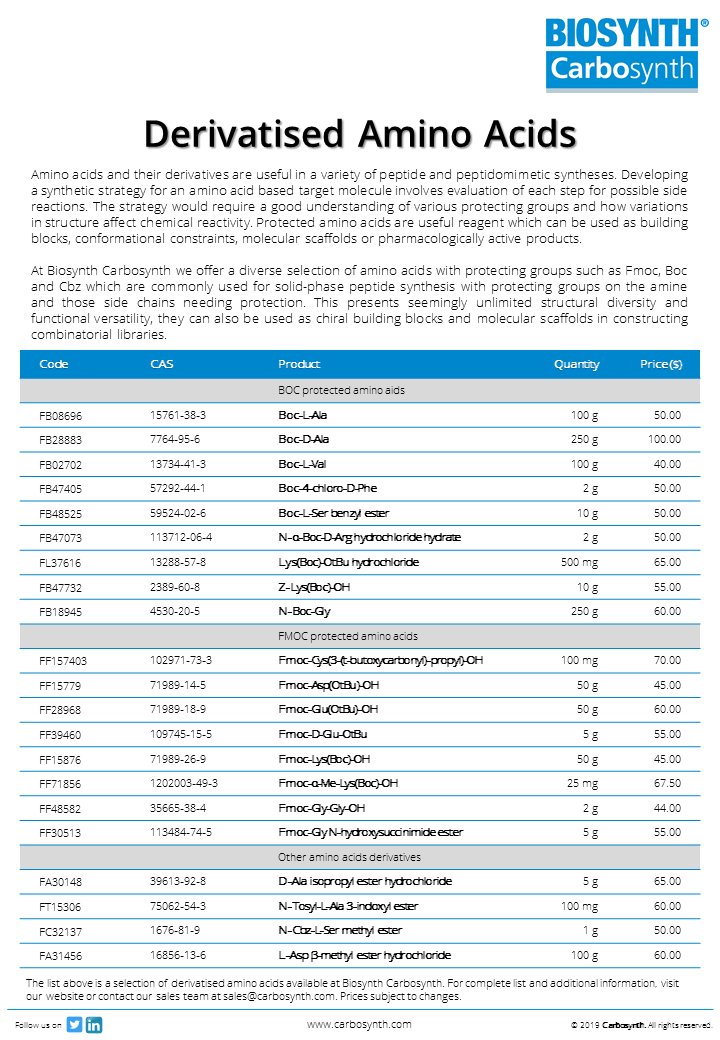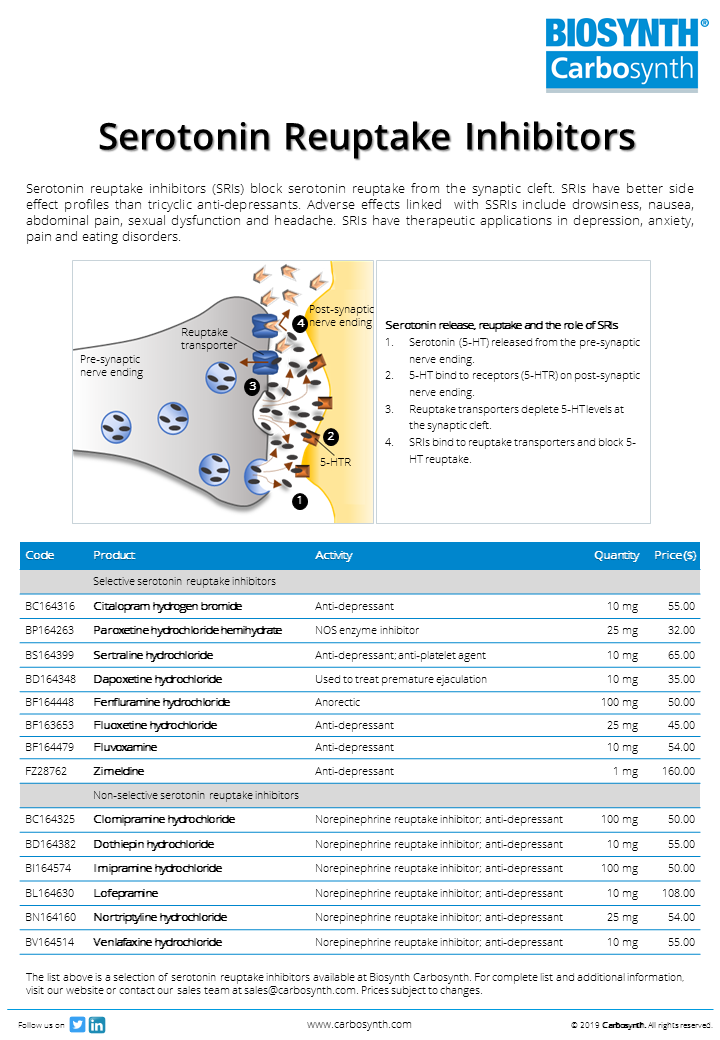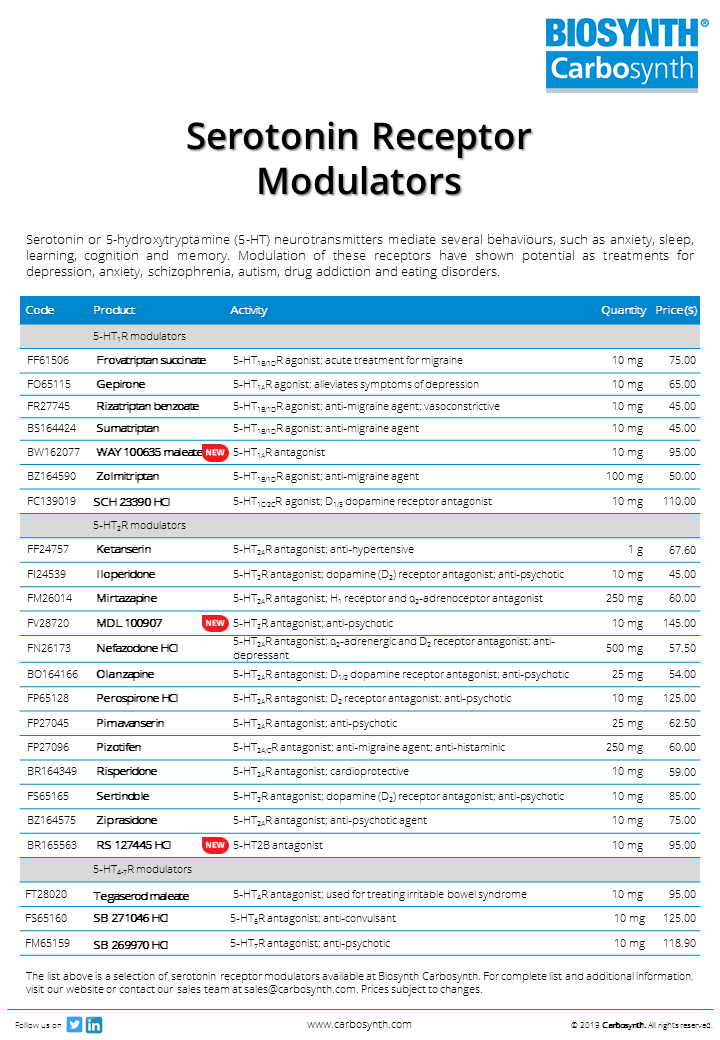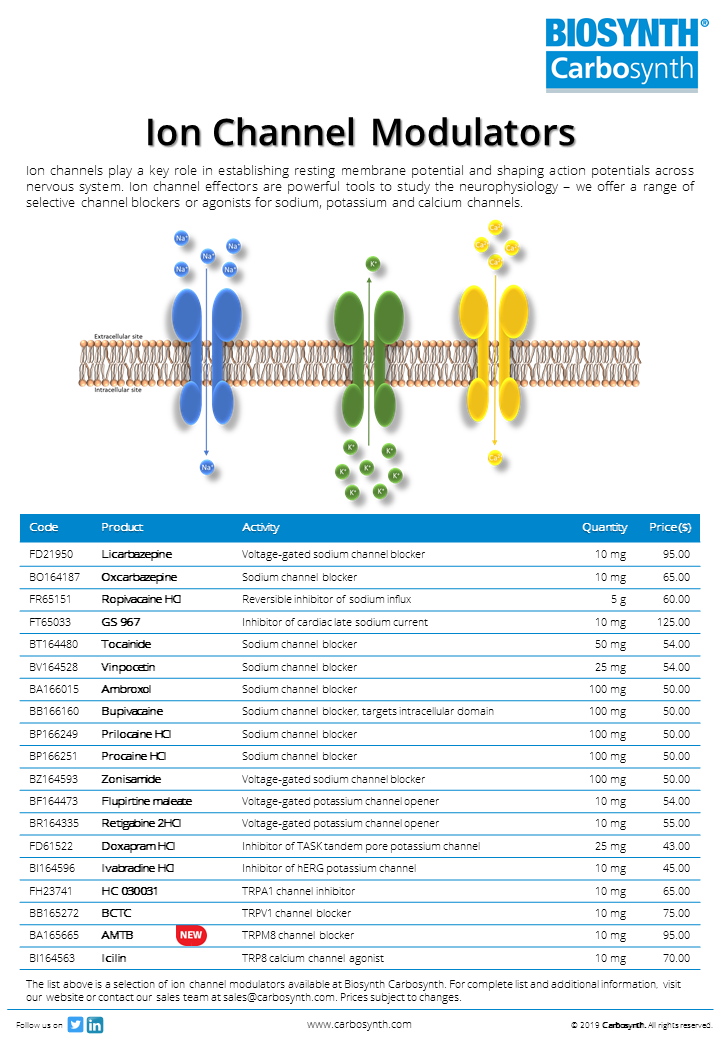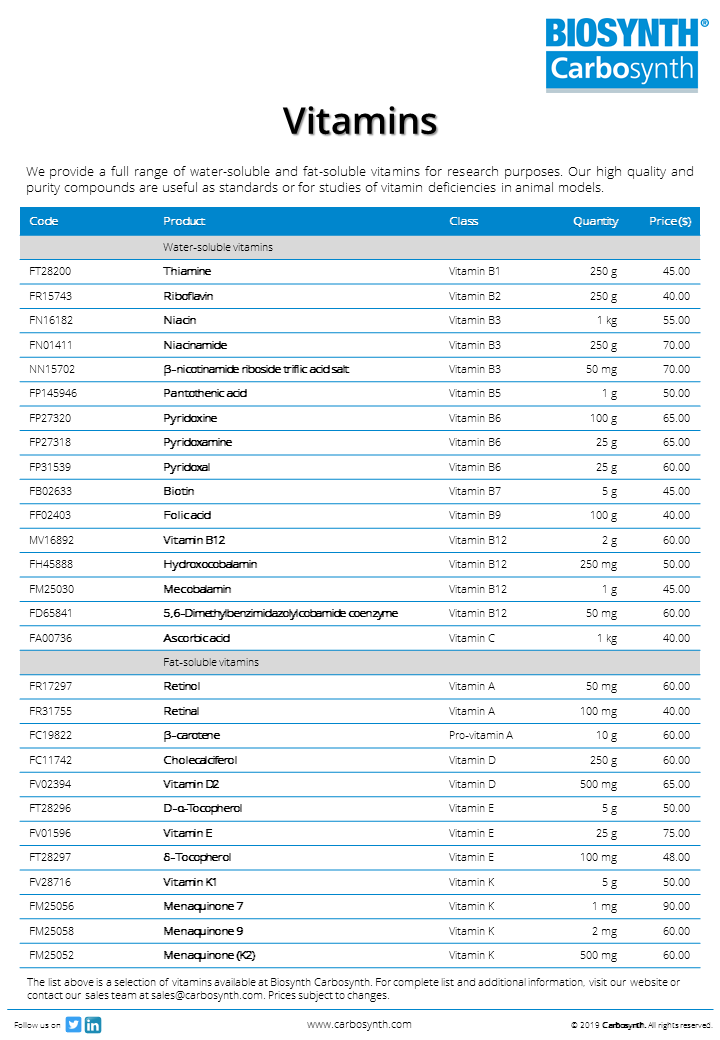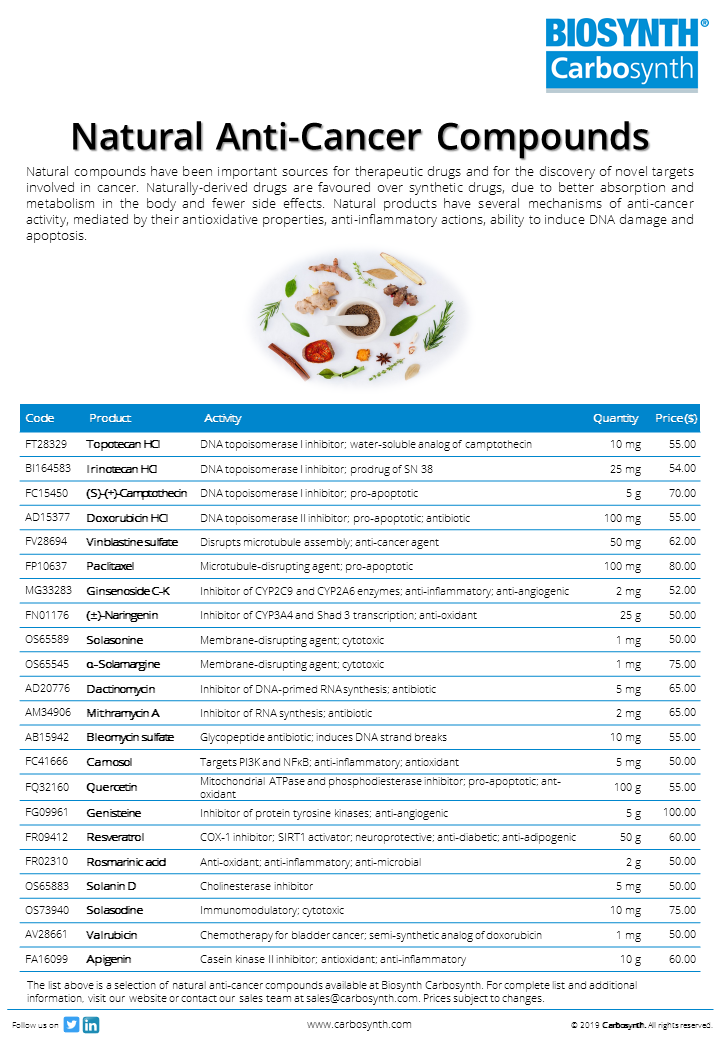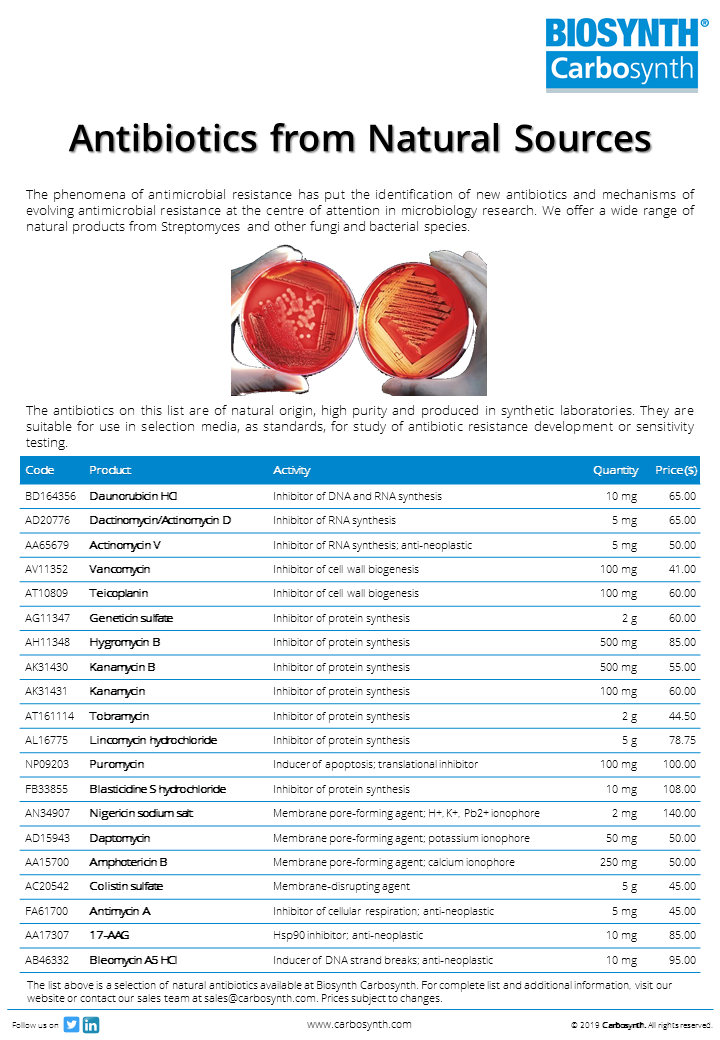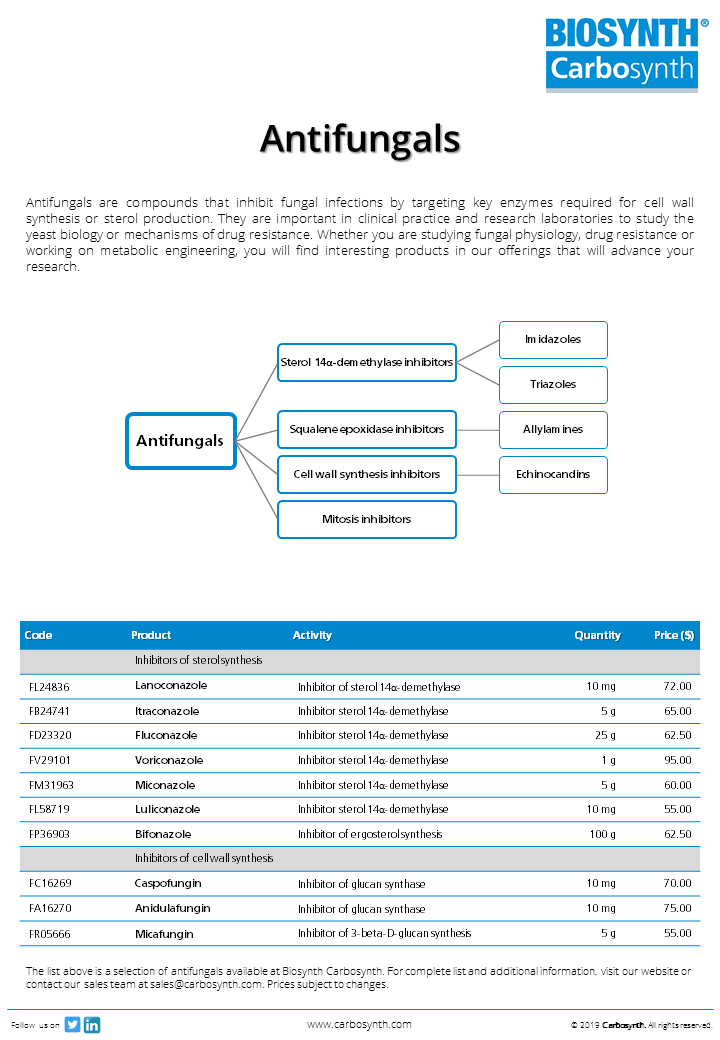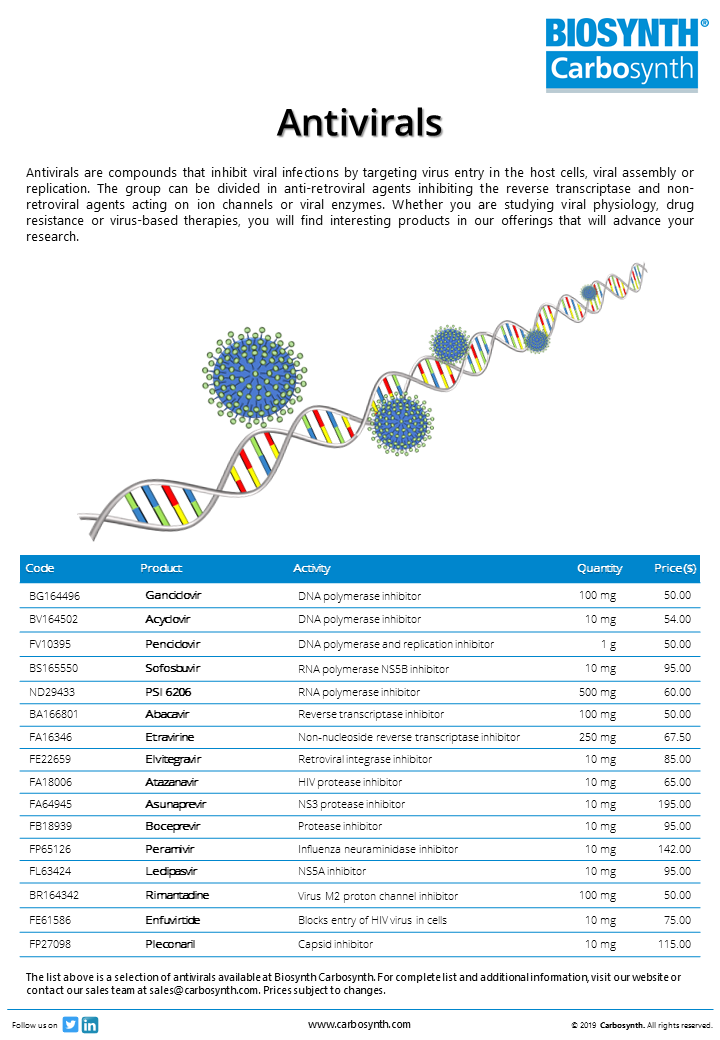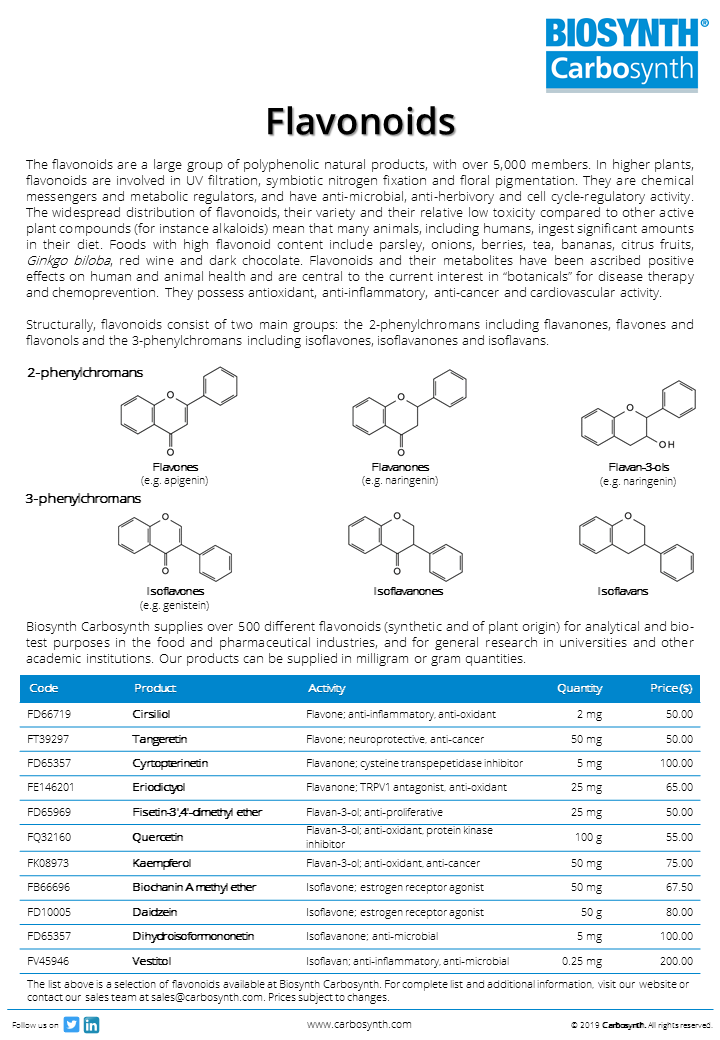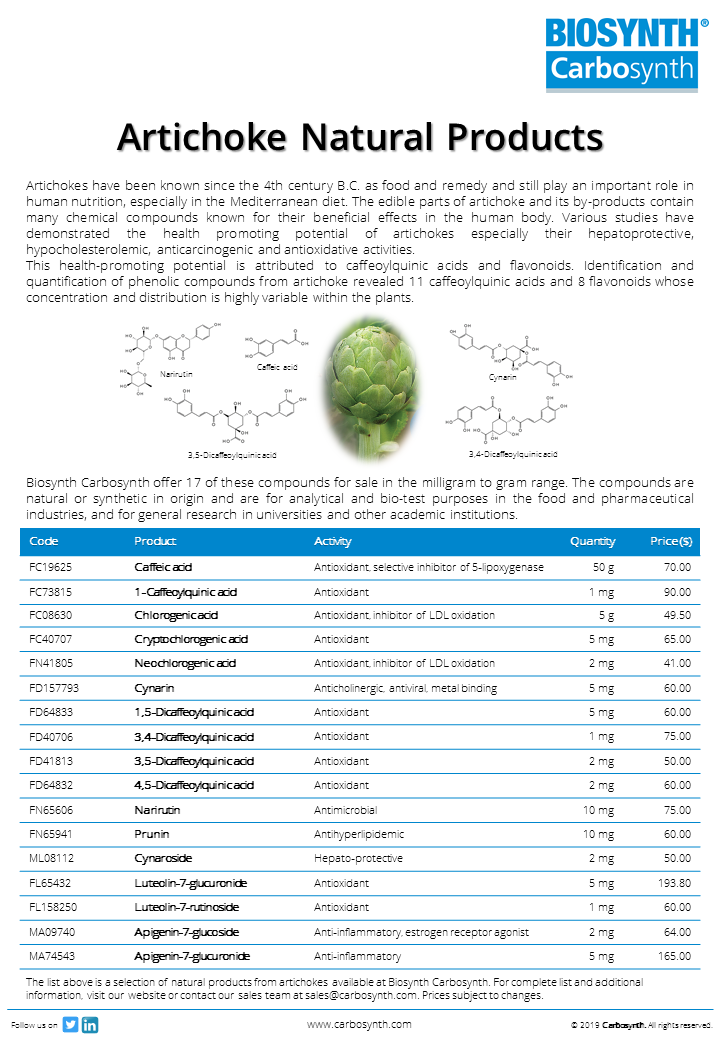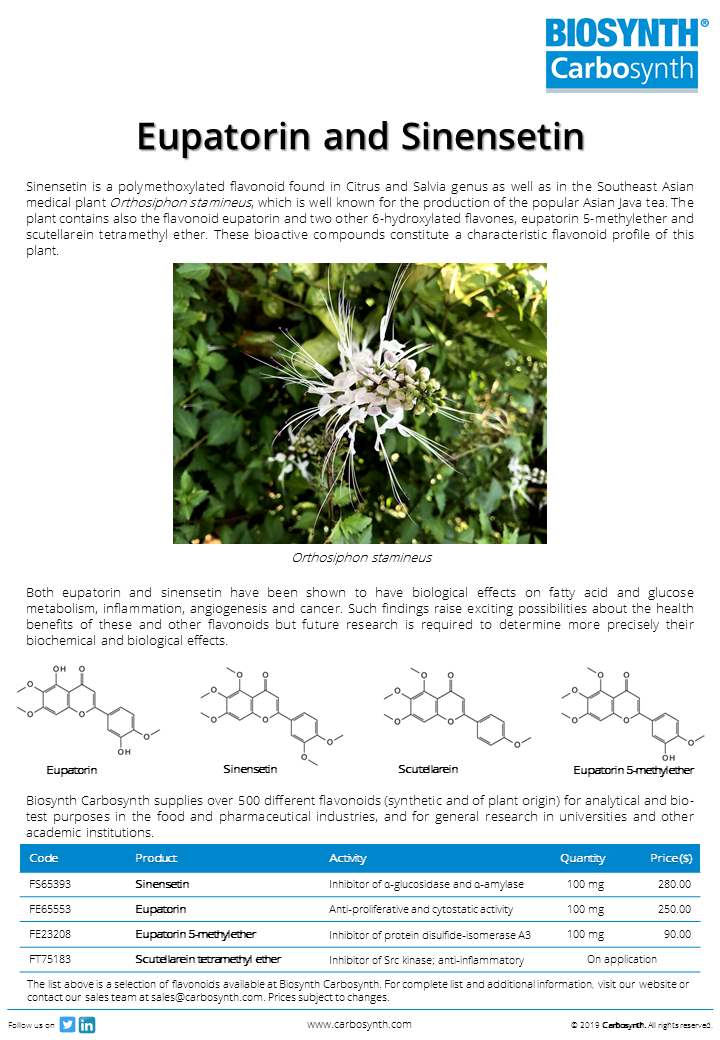代理品牌 Agency
Biosynth Carbosynth
Biosynth Carbosynth 是一個新的全球品牌,由精細化學品市場中的兩個主要供應商合併而成。是製藥,生命科學,食品,農業化學,化妝品和診斷領域許多機構的首選供應商。Biosynth Carbosynth生產各種化學和生化產品,從克到噸的量級皆可提供,並專門從事碳水化合物,核苷酸,抗生素,醫藥中間體,酶受質的生產。
Biosynth Carbosynth的工廠位於三大洲,在瑞士,英國,斯洛伐克和中國設有製造實驗室,並在美國設有銷售中心。具有足夠的研發資源和現代化生產設施,更以敏捷的管理和快速的溝通,使其能快速有效地回應客戶和市場需求。強調創新精神,隨時與客戶及研發人員保持密切關係。積極開發新型化學品,如化學發光的AquaSpark®產品系列。
Biosynth Carbosynth客製化合成是業務開展的一大重心。我們在酶受質,有機合成,碳水化合物和核苷酸修飾方面擁有領先的專業技術。此外,品質一直是企業的核心,所有製作流程皆依循ISO和GMP標準。
- 推薦產品
- 目錄下載
- 產品文宣
| Code | Cas No | Product | Description |
|---|---|---|---|
| EC05990 | 157843-41-9 | 2-Chloro-4-nitrophenyl a-L-fucopyranoside | Alternative chromogenic substrate for β-D-galactosidase |
| EA06838 | 132489-69-1 | (Z)-PugNAc | Inhibitor of O-GlcNAcase and β-hexosaminidase |
| EB06680 | 7240-90-6 | X-Gal | Chromogenic substrate for β-galactosidase; used in immunohistocytochemistry |
| EN06363 | 369-07-3 | 2-Nitrophenyl b-D-galactopyranoside | β-galactosidase substrate; colorimetric assays; environmental impact assessment |
| EI05931 | 367-93-1 | Isopropyl b-D-thiogalactopyranoside - non-animal origin | Analog of allolactose; inactivates lac repressor and triggers transcription |
| FD05800 | 25952-53-8 | 1-(3-Dimethylaminopropyl)-3-ethylcarbodiimide HCl | Water soluble reagent; carboxyl activating agent; used in immunoconjugates |
| FH05522 | 13161-30-3 | 2-Hydroxypyridine-N-oxide | Used in peptide coupling reactions as a substitute for HOBt |
| FD03725 | 78342-42-4 | (S)-2,5-Dihydro-3,6-dimethoxy-2-isopropylpyrazine | Chiral auxiliary used in synthesis of stereoselective α-amino acids derivatives |
| FD04039 | 109838-85-9 | (R)-2,5-Dihydro-3,6-dimethoxy-2-isopropylpyrazine | Chiral auxiliary used in synthesis of stereoselective α-amino acids derivatives |
| MA00746 | 131-48-6 | N-Acetylneuraminic acid | Biologically relevant in neurotransmission and carbohydrate-protein recognition |
Monosaccharide Catalogue
- Protected and functionalised monosaccharides.
- Rare sugars: D- and L-forms of allose, altrose, arabinose, cellobiose and more.
- Serve as building blocks for oligosaccharides, nucleosides and other sugar derivatives.
Oligosaccharide Catalogue
- More than 500 oligosaccharides available, from di- to hepta-saccharides.
- Includes chito, heparin, lacto, lewis, malto and sialyl type oligosaccharides.
- Functionalised oligosaccharides also available for linkage with peptides, proteins and lipids.
- Special interest in blood group sugars for development of blood filtration technology.
Polysaccharide Catalogue and Handbook
- Polysaccharides from higher plants, animal tissues, lichens, algae and microorganisms.
- Functionally modified polysaccharides: biotin, rhodamine and fluorescein conjugates and much more.
- Formulated and artificial polysaccharides.
- Contains a technical section on polysaccharide analytical methods and infomation on product properties.
Nucleoside Catalogue
- The source for nucleosides, nucleotides and phosphoramidites.
- Building blocks for use within pharmaceutical and biotechnology area.
- Diverse functionality and protecting groups on a range of nucleosides.
- A range of modified nucleosides to prepare oligonucleotides for antisense and drug discovery compounds.
Enzyme Substrate and Detergent Catalogue
- Diagnostic tools for molecular biology, biochemistry and microbiology.
- Bioluminescent, chromogenic and fluorogenic enzyme substrates for diagnostic staining and probing.
- Enzyme substrates for culture media, diagnostics, food and environmental testing.
- Detergents for lysing cells, solubilising membrane proteins and reducing non-specific binding in assays.
Impurity and Metabolite Catalogue
- Reference standards for your quality needs.
- Collection of over 800 impurity reference standards derived from more than 300 APIs.
- Range of synthetic impurity standards and known metabolites of APIs.
- Resynthesised to the highest purity and supplied with comprehensive analytical data.
Glycosyltransferase Inhibitors
The control of protein glycosylation is of major importance for the structural and functional studies of glycoproteins. Glycan chains play a key role in the stability, activity, antigenicity and pharmacodynamics of biotherapeutics. Inhibitors of glycosyltransferases allow better control over the biosynthesis of well-defined and homogeneous glycoforms in the production of recombinant glycoproteins and therapeutic monoclonal antibodies.
Glycoside Hydrolase Inhibitors
Protein glycosylation is a post-translational modification involved in protein folding and stability, signalling, immune system, carbohydrate antigen production and cell differentiation. Glycoside hydrolase inhibitors are compounds that inhibit the enzymatic hydrolysis of glycosidic bonds, allowing control of the oligosaccharide pattern on glycoproteins.
N-Glycans
Asparagine-linked glycans (N-glycans) are structurally diverse compounds, based on a core pentasaccharide (Man3GlcNAc2). N-Glycans are components of glycoproteins, glycolipids and proteoglycans that are involved in several biological processes such as protein folding, membrane receptor signaling and immune response. Synthetic N-glycans have therefore wide-spread applications as research and analytical tools to study the diverse roles of N-glycans.
Sugar Nucleotides
Sugar nucleotides are known as activated sugars and are composed of a nucleoside and a monosaccharide residue linked by a pyrophosphate moiety. They are key substrates for the synthesis of complex polysaccharides and the glycosylation of peptides and lipids.
Carbohydrate Labelling
Metabolic labelling of carbohydrates is a useful tool to study the role of specific carbohydrate structures within cells. Herein, the endogenous synthesis and modification machinery of living cells allows to incorporate detection or affinity tags into biomolecules.
Nucleic Acid Labelling
Click chemistry allows selective, quantitative and cell-compatible conjugation of nucleic acids with different markers. The labelling consists of a two-step protocol: I) functionalized nucleosides are incubated with cells and incorporated in DNA/RNA by the replication/transcription machinery. II) The conjugation with a functionalized fluorophore occurs in the presence of a Cu (I) catalyst.
Gangliosides
Gangliosides are membrane-bound molecules composed of a hydrophobic ceramide tail and a hydrophilic oligosaccharide head. They can be categorized according to the number of sialic acid residues present in the sugar domain – GA for a-sialyted gangliosides, GM for mono-sialyted, GD, GT and GQ for di-, tri- and tetra-sialyted oligosaccharides, respectively.
Sphingolipids
Sphingolipids are membrane-embedded molecules composed of a sphingosine and a fatty acid. They have important signaling and regulatory roles in cell gcontainer small flexBox nogapth, cell death, senescence, adhesion, migration, inflammation, angiogenesis, intracellular trafficking, membrane reorganization, neuron differentiation, etc.
Denaturing Detergents
Detergents break protein-protein interactions and mask the protein electric charge by rendering it either negative (e.g. SDS) or positive (e.g. CTAB). Ionic detergents are used for the disruption of membranes, denaturation of proteins, solubilization of DNA and for protein separation during denaturing gel electrophoresis.
Non-Denaturing Detergents
Non-denaturing detergents do not break protein-protein interactions or compromise the native protein structure. Non-ionic detergents are mild and break lipid-lipid and protein-lipid interactions. They are an essential tool for the purification of enzymes or multimeric proteins in its native state.
Fluorogenic Lysosomal Enzyme Substrates
Carbosynth offers a range of fluorogenic lysosomal enzyme substrates that can be employed to assay enzyme activity for diagnosing lysosomal storage disorders (LSD). The products in this range are of high chemical purity, as well as biochemical purity.
Diabetes Research
Diabetes is a complex metabolic disorder driven by genetic and environmental factors, affecting more than 420 million people worldwide. If untreated, this chronic condition leads to a series of secondary complications such as eye, kidney and peripheral nerve damage, as well as stroke. Development of new therapies for management and prevention of this disease are of major interest in healthcare.
Cardiovascular Research
Cardiovascular diseases are the leading cause of death worldwide. This group of diseases includes disorders of the heart and blood vessels, such as coronary heart disease, pulmonary embolism and stroke. Despite advancements in surgical methods, the risks involved favour the use of pharmacological agents that target various pathophysiological aspects of cardiovascular diseases, such as hypertension, inflammation and hypercholesterolemia.
Stem Cell Modulators
The rapidly gcontainer small flexBox nogaping field of stem cell research has a great potential to revolutionize healthcare. The understanding of physiology, epigenetics and regulation of embryonic stem cells, tissue stem cells or induced pluripotent stem cells is allowing the design of novel therapies and approaches for regenerative medicine. Look at the collection of stem cell modulators here.
Epigenetic Chemical Tools
Epigenetics has been an exciting and gcontainer small flexBox nogaping research area for the last 50 years, which has led to good understanding of molecular mechanisms underlying gene expression in eukaryotes. Whether you are developing new technologies for regenerative medicine, investigating epigenetic abnormalities in cancers, immunological and neurological diseases, you will find a range of compounds to advance your research here.
Heat Shock Protein Modulators
Heat shock proteins (HSPs) aid correct folding and restore 3D structure of proteins, following cellular stress. Additionally, they are involved in intracellular protein transport and cellular regulation. There are six families of HSPs, of which HSP70 and HSP90 are of the chaperonin family. HSP90 is often overexpressed in cancer and promotes tumor cell survival, by preventing apoptosis and stabilizing oncogenes, such as HER2 and BCR-ABL tyrosine kinase. These chaperonins are therefore exploited as therapeutic targets in cancer.
Cannabinoid Receptor Modulators
Synthetic cannabinoid ligands have been used and studied for several therapeutic applications. Stimulation of cannabinoid receptors by endocannabinoids, result in neuro-modulatory responses, similar to the effects caused by the psychoactive agents found in cannabis.
Ionotropic Glutamate Receptor Modulators
Ionotropic glutamate receptors (iGluRs) transduce signals from pre-synaptic neurons into excitation of post-synaptic neurons upon glutamate binding. The receptors are made of four subunits and form ligand-gated channel pores that control the sodium and calcium currents. They are involved in synaptic plasticity and pathogenesis of schizophrenia, depression, Alzheimer’s and Parkinson’s disease.
Metabotropic Glutamate Receptor Modulators
Metabotropic glutamate receptors (mGluRs) are members of class C G-protein-coupled receptors that participate in modulation of synaptic transmission and neuronal excitability throughout the central nervous system. The mGluRs regulate NMDA receptor activity and any disfunctions can lead to impaired signal transduction resulting in neurological disorders such as epilepsy, schizophrenia, autism, night blindness, Parkinson’s and Alzheimer’s disease.
Dopamine Receptor Modulators
Dopamine transporters regulate dopamine depletion from synaptic clefts to terminate neurotransmission. Inhibiting these transporters have uses in bipolar disorder, depression, as anorectic agents and psychomotor stimulants.
Derivatised Amino Acids
We offer a diverse selection of amino acids with protecting groups such as Fmoc, Boc and Cbz which are commonly used for solid-phase peptide synthesis with protecting groups on the amine and those side chains needing protection. They can also be used as chiral building blocks and molecular scaffolds in constructing combinatorial libraries.
Serotonin Reuptake Inhibitors
Serotonin reuptake inhibitors (SRIs) block serotonin reuptake from the synaptic cleft. SRIs have better side effect profiles than tricyclic anti-depressants. Adverse effects linked with SSRIs include dcontainer small flexBox nogapsiness, nausea, abdominal pain, sexual dysfunction and headache. SRIs have therapeutic applications in depression, anxiety, pain and eating disorders.
Serotonin Receptor Modulators
Serotonin or 5-hydroxytryptamine (5-HT) neurotransmitters mediate several behaviors, such as anxiety, sleep, learning, cognition and memory. Modulation of these receptors have shown potential as treatments for depression, anxiety, schizophrenia, autism, drug addiction and eating disorders.
Ion Channel Modulators
Ion channels play a key role in establishing resting membrane potential and shaping action potentials across nervous system. Ion channel effectors are powerful tools to study the neurophysiology – we offer a range of selective channel blockers or agonists for sodium, potassium and calcium channels.
Vitamins
We provide a full range of water-soluble and fat-soluble vitamins for research purposes. Our high quality and purity compounds are useful as standards or for studies of vitamin deficiencies in animal models.
Natural Anti-Cancer Compounds
Natural compounds have been important sources for therapeutic drugs and for the discovery of novel targets involved in cancer. Natural products have several mechanisms of anti-cancer activity, mediated by its antioxidative properties, anti-inflammatory actions, ability to induce DNA damage and apoptosis.
Antibiotics from Natural Sources
The phenomena of antimicrobial resistance has put the identification of new antibiotics and mechanisms of evolving antimicrobial resistance at the centre of attention in microbiology research. We offer a wide range of natural products from Streptomyces and other fungi and bacterial species.
Antibiotics
Antibiotics are key compounds in every microbiology and molecular biology laboratory. This group of products is particularly interesting since it touches one of the hottest topics in today’s microbiology research environment – the antimicrobial resistance. Whether you are engineering new bacterial strains or looking at development of antibiotic resistance mechanisms in bacteria, you will find interesting products in our offerings that will advance your research.
Antifungals
Antifungals inhibit fungal infections by targeting key enzymes required for cell wall synthesis or sterol production. They are important in clinical practice and research laboratories to study the yeast biology or mechanisms of drug resistance. Whether you are studying fungal physiology, drug resistance or working on metabolic engineering, you will find interesting products in our offerings that will advance your research.
Antivirals
Antivirals inhibit viral infections by targeting virus entry in the host cells, viral assembly or replication. The group can be divided in anti-retroviral agents inhibiting the reverse transcriptase and non-retroviral agents acting on ion channels or viral enzymes. Whether you are studying viral physiology, drug resistance or virus-based therapies, you will find interesting products in our offerings that will advance your research.
Flavonoids
Flavonoids are a group of polyphenolic natural products with over 5,000 members acting as allelochemicals, anti-microbial and anti-herbivory agents. Flavonoids and their metabolites have positive effects on human and animal health and are central to the current interest in “botanicals” for disease therapy and chemoprevention. They possess antioxidant, anti-inflammatory, anticancer and cardiovascular activity.
Artichoke Natural Products
Artichokes are rich in caffeoylquinic acids and flavonoids and reported to have health-promoting effects. Carbosynth offer 17 artichoke compounds for sale in the milligram to gram range either individually or as part of a kit. The compounds are of natural or synthetic origin for analytical purposes in the food and pharmaceutical industries, and for research in universities and other institutions.
Eupatorin and Sinensetin
Eupatorin and sinensetin are flavonoids found in Citrus and Salvia genus that have biological activities on fatty acid and glucose metabolism, inflammation, angiogenesis and cancer.


